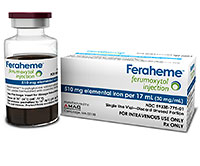Product
Feraheme
Approval Date
June 30, 2009
Release Date
Second half of July 2009
Company
AMAG Pharmaceuticals, Inc.
Class
Iron Replacement
Indication
Injection for intravenous (IV) use as an iron replacement therapy for the treatment of iron deficiency anemia in adult patients with chronic kidney disease.
Active Ingredient
Ferumoxytol
Agency Roster
Dudnyk
Marketing Strategy/Execution
AMAG will be marketing and selling Feraheme in the US through its commercial organization consisting of approximately 150 seasoned professionals, including an 80-person specialized sales force, an experienced account management and reimbursement team and a contract nurse team. Feraheme is being distributed through wholesalers and specialty distributors.
AMAG also wants to convey the message that Feraheme provides safe and effective therapy to treat iron deficiency anemia in adult patients with chronic kidney disease. The wholesale acquisition cost (WAC) of Feraheme is $396.78 per 510 mg vial.
Physician Outlook
AMAG Pharmaceuticals’ Feraheme (ferumoxytol), an IV injection treating iron deficiency anemia in adult patients with chronic kidney disease, has the potential to cause shifts in the CKD treatment paradigm. Feraheme’s greater hemoglobin increases and toleration profile will likely position it as a welcome alternative to oral iron therapy.
—Mary McBride, Associate Vice President, Research, GfK Healthcare
Also in the Pipeline (courtesy of Adis R&D Insight)
Drug: AF 37702
Manufacturer: Affymax
Indication: Anaemia (in patients with renal failure)
Active ingredient: Erythropoietin mimetic
Phase: III
Drug: FerinjectÂ
Manufacturer: Vifor/ Fresenius Medical Care
Indication: Anaemia
Active ingredient: Ferric carboxymaltose
Phase: Launched
Source: Wolters Kluwer Health
Recent MM&M Coverage
The Top 75: Dudnyk
Pharmacology
Feraheme is a colloidal form of iron (superparamagnetic iron oxide coated with polyglucose sorbitol carboxymethylether) that is formulated with mannitol. The carbohydrate coating helps isolate the bioactive iron until the iron-carbohydrate complex enters the reticuloendothelial system macrophages in the liver, spleen, and bone marrow. After its release from the complex, the iron enters the intracellular iron storage pool (eg, ferritin), or is transferred to plasma transferrin for transport to erythroid precursor cells for incorporation into hemoglobin.
Feraheme is not dialyzed.
Clinical Trials
Three randomized, open-label controlled clinical trials were conducted to assess the safety and efficacy of Feraheme for the episodic treatment of iron deficiency anemia in patients with chronic kidney disease. Patients were randomized to either oral iron therapy (ferrous fumarate 200mg iron/day for 21 days) or Feraheme (two 510mg injections). Trials 1 and 2 enrolled patients with CKD not on dialysis, and Trial 3 enrolled patients with CKD on hemodialysis. The changes in hemoglobin (g/dL) from baseline to day 35 in the three trials were 1.2, 0.8, and 1.0 for groups given the study drug, and 0.5, 0.2, and 0.5 for the oral iron therapy groups. Transferrin saturation and ferritin measurements also showed improvement for the Feraheme groups compared to the oral iron therapy groups. These trials also included an elective uncontrolled, follow-up phase in which patients with persistent iron deficiency anemia were given two additional 510mg injections of Feraheme. Overall, the majority of these patients (70%) experienced a further increase in hemoglobin, transferrin saturation and ferritin. The mean change in hemoglobin level from the retreatment baseline for patients with an increase in hemoglobin was 0.86g/dL and was 0.5g/dL for all patients.
Adverse Reactions
Diarrhea, nausea, hypotension, dizziness, constipation, peripheral edema; infusion reactions, hypersensitivity reactions (eg, rash, pruritus, urticaria, wheeze).
Adults
Give undiluted by IV injection at a rate up to 1mL/sec (30mg/sec). Initially 510mg, then an additional dose 3–8 days later. May repeat in persistent or recurrent iron deficiency anemia. Hemodialysis: give at least 1 hour after starting hemodialysis and after BP is stable.
Children
Not recommended.
Contraindications
Iron overload. Anemia not due to iron deficiency.
Precautions
Monitor for hypotension, and for hypersensitivity for at least 30 minutes, after injection. Evaluate hemoglobin, ferritin, iron, transferrin saturation at least 1 month after 2nd injection. Have equipment/personnel available to treat hypersensitivity reactions. Pregnancy (Cat.C). Nursing mothers: not recommended.
Interactions
May transiently (up to 3 months) affect diagnostic ability of MRI (see literature).









